Electric field along axis with two charged rings
Example 1 Equal Charge Rings - Equal Radii- Both
rings have the same charge .. just move them apart - away from the origin
- and see how the net field changes.
|
Introduction : In discussing the
electric field between (and away from) two charged rings along the X
axis .. we started playing "battle of the rings" to see
where the E field would be zero .. and if that would be a stable point
or not. We use the convention that we plot the electric field pointing
right on the the +y axis, and the electric field pointing left on the
-y axis. Assume a single positively charged ring at the origin. We use
the standare equation for the electric field along the axis from a
charged ring - as shown to the right. |
 |
|
General shape of the curve? This
will create an electric field that points right, on the right side of
the ring, and points left on the left side, with a zero point at the
middle of the ring (x=0). Now, since, from far away, this ring will "look
like" a point charge, there must be a local maximum at some
distance out from the ring on each side. If we solve for that
location, we find it to be = R/sqrt(2). To the right is a picture of
the general shape of the curve. [Note, in this picture, the radius of
the ring is 3*sqrt(2) units, so the peak occurs at x=3 .] |
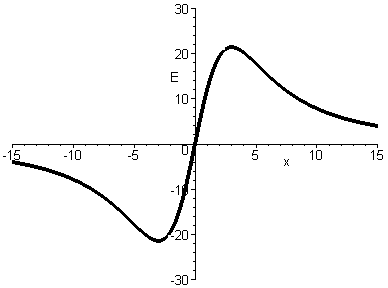 |
Equilibrium Points? If the electric
field is zero at a point along the axis, there will be no force on a test
charge placed there (regardless of the sign of the test charge). But, if
we move the test charge away from that point slightly, either it will want
to return (stable) or it will want to keep going away (unstable). Using
our plotting convention, the slope of the E curve, as it crosses that E=0
point, indicates which sign of the test charge will be unstable : that is,
if the slope is positive, then a positive test charge will find that an
unstable equilibrium point, but a negative test charge will find it a
stable equilibrium point, and vice versa. Notice, that so far, there is
only one zero point .. at the origin of the ring - and this will be
unstable for postitive test charges (since the slope is positive). If you
move a test charge slightly away from the ring, it will continue to move
away!
|
Two rings? To make it more
interesting, let's have two charged rings, but to make it easier on
ourselves, let's have the both the same radius and the same charge. In
this case, if we have them separated by a distance, there will still
be a point exactly between them where the Electric field is zero ..
and eqilibrium point. First, we tried moving the rings a little bit
apart ... and we got a modified field picture, but seemed reasonable
(and the center, the slope was still positive). (Note that the blue
curve is the left ring, at 2 units behind the origin, and the yellow
curve is the right ring, at 2 units in front of the origin ... the
Green is the net electric field.) |
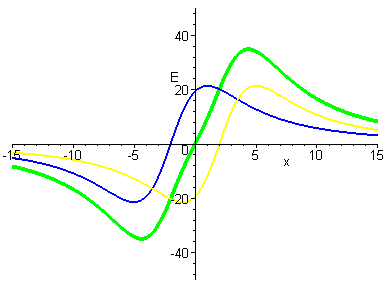 |
|
Move the rings farther apart? But,
as we moved the rings farther apart ... the curve shifted to a
negative slope! Here is an example. |
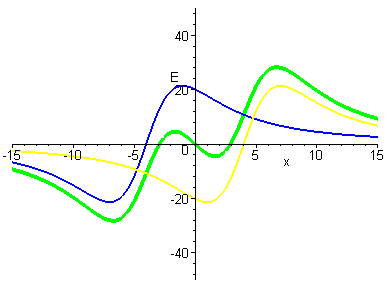 |
|
Animation of moving the rings? The
next logical question is .. where is that crossover, and what does it
look like?.
Here is an animation of the large scale view as we move from
superimposed to a distance of 12 units out for each ring (thus the
origin is always the zero point for the system - but we see other
zeros show up!). |
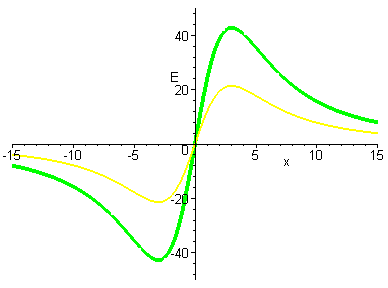 |
|
Close up view of what happens at the center?
When exactly does the change occur?
It turns out when the maximum from one ring is at the origin, and the
maximum of the other ring is at the origin (so in this case, when one
ring is at x=-3, and the other is at x=+3, there will be an inflection
point at the origin. .. Then the slope will switch signs!) This means
that the + test charge unstable point, if the rings are close
together, has become a stable point (if the rings are farther apart).
Here is an animation of the zoomed in view view as we move from
superimposed to a distance of 5 units out for each ring (in steps of
0.5 units). (The animation pauses at the "magic moment".)
[Notice that two more zeros appear ..
both are unstable for the + test charge .. it could "squeeze out"
of the system at those points (see the explanation below).] |
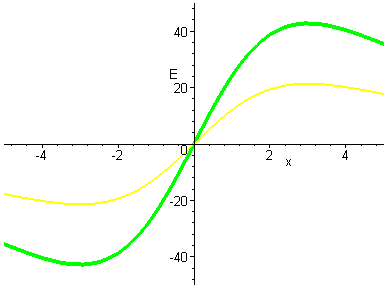 |
What is a conceptual understanding of this changeover? Well,
think of it this way .. if there is one ring, the center is an unstable
point for a + test charge .. it wants to escape if it moves slightly away
from the ring. Now, as you start to separate the rings, both are pushing
at that + test charge, so you might think it would be held there, but, if
it moves a little closer to one of the rings, the electric field actually
decreases relative to that ring, and since it is moving farther from the
other ring, that contribution also decreases .. so it says, "hey, I
can escape!". Now, if the rings move farther apart, so that the place
where the test charge is located will be beyond the "local maximum"
of the individual rings, now if the test charge moves closer to one ring,
it is fighting a bigger electric field, thus it wants to stay put ...
STABLE!
How did I create these images? This was
the problem that forced me to sit down and play around with Maple. I had
to learn how to put in the equations, and get the plots that I wanted. To
create the above animated gifs, I just exported out a series of images,
and then used GifAnimator to string them together. (Maple has the ability
to kick out an animated gif from an animation, I think .. but I haven't
gotten that far yet!). If you want the simple file I used to generate
these pictures, download this file [By
that, I mean right-click on this link and save the file .. if you click
the link you'll get a glorious page of "junk text"!] . I've
tested it on Maple 5.1 and Maple 6.0.
It takes
338
licks to get to the center of a Tootsie Pop?





